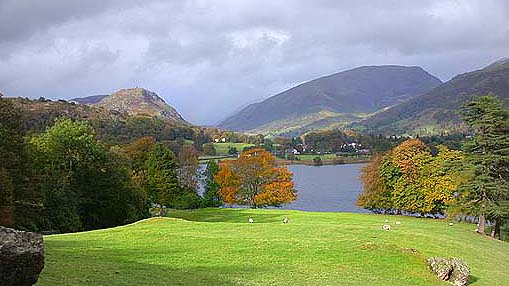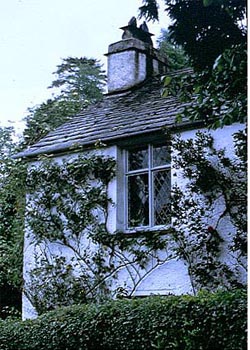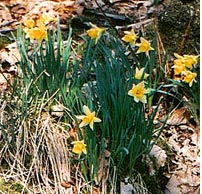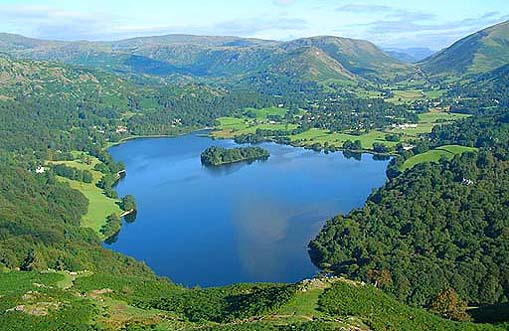Wordsworth's Lakes
by Keith Kellett
Mr. Walsh of the British Home Office was on a mission. The year was 1797, and Britain was at war with France. A village doctor in Somerset had written to the Home Secretary, reporting strange goings-on at a nearby house called Alfoxden.
'-- the Master of the house has no wife with him' wrote the doctor 'but only a woman who passes for his Sister. The man has Camp Stools which he and his visitors take with them when they go about the country on their nocturnal or diurnal excursions, which they have been heard to say were almost finished. They have been heard to say they should be rewarded for them, and were very attentive to the river near them ...'
After some months observing these 'suspicious characters', the diligent Mr. Walsh reported that he thought this was '-- no French affair, but a mischievous gang of disaffected Englishmen.'
Even if Mr. Walsh had known this 'mischievous gang' centred on poet William Wordsworth, his sister Dorothy and their friend and frequent visitor Samuel Taylor Coleridge, he would probably not have altered his opinion. At that time, the works of neither Wordsworth nor Coleridge received much notice outside literary circles.
It wasn't until the following year that 'Lyrical Ballads', a volume in which both poets collaborated, was published. They intended it to finance a short stay in Germany, after which, following a decade of rather nugatory study, and wandering around Britain and Europe, Wordsworth returned to his roots, and began to produce some of his best work.
Those roots were in England's Lake District. His birthplace was nearby, at Cockermouth, in Cumberland and, at the age of nine, he was sent to school at Hawkshead, Lancashire, right in the heart of the Lakes. He boarded in the village with a Mrs. Tyson, and here his life-long love affair with the Lakes began.
Wordsworth's poetry frequently recalls those childhood days, when much of his spare time was spent boating, skating, riding or just wandering around the hills, woods and lake shores.

By world standards, the Lake District's mountains aren't very high; the loftiest just manage to top 3000 feet. Wordsworth was later to liken the mountain ridges which make up the area to the spokes of a wheel, with the sixteen lakes lying in the narrow glaciated valleys between them.
Wordsworth and Dorothy came to live in Grasmere, in Westmorland, on their return from Germany in 1799. The village lies almost at the head of a long valley containing the lakes of Grasmere, Rydal Water and England's largest lake, Windermere.
Wordsworth found a little cottage for rent at Town Head, just outside the village, while on a walking tour to introduce Coleridge to the Lakes. It had once been a wayside inn, 'The Dove and Olive Branch'. Later tenants named it 'Dove Cottage', although the Wordsworths never called it so.
 Wordsworth only lived at Dove Cottage for eight years. That's no time at all compared with the 37 years he lived at nearby Rydal Mount. But the cottage is inextricably linked with his name, probably because, while there, he produced some of his best-known and most enduring work.
Wordsworth only lived at Dove Cottage for eight years. That's no time at all compared with the 37 years he lived at nearby Rydal Mount. But the cottage is inextricably linked with his name, probably because, while there, he produced some of his best-known and most enduring work.
Dorothy Wordsworth's Grasmere Journal gives us intimate glimpses of life in their first three years at the cottage. It ends, abruptly, on 16th January 1803, when they walked into the village to buy some of the now famous speciality gingerbread.
At first, it was only William and Dorothy. But, frequently, their sailor brother, John, visited whenever he had leave from his ship. Their childhood friend, Mary Hutchinson, who Wordsworth was to marry in 1802, often came to stay, bringing her sister, Sarah.
Coleridge and his family followed the Wordsworths to the Lakes, and rented a part of Greta Hall, near Keswick, in Cumberland. He, too, was a frequent and welcome visitor, although his visits meant a walk of 13 miles over a steep mountain pass. But, sometimes, he would divert via the 3000-foot summit of Helvellyn!
Coleridge left Greta Hall in 1803, and the poet Robert Southey moved in. Southey and Coleridge were married to two sisters. Despite this, they frequently quarrelled, but had a mutual friend in Wordsworth, so they've all been 'packaged' together as 'The Lake Poets'.
Faithfully, Dorothy recorded visits, walks and literary and domestic detail combined. On Thursday, 30th July 1800, she wrote:
'All the morning I was busy copying poems. Gathered peas, and in the afternoon Coleridge came, very hot, he brought the second volume of the 'Anthology'. The men went to bathe, and we afterwards sailed down to Loughrigg. Read poems on the water, and let the boat take its own course. We walked a long time upon Loughrigg, and returned in the grey twilight. The moon was just setting as we came home.'
At last, the restless poet was able to settle. Maybe the wooded lake-shores, the valleys and the low but rugged hills reminded him of his cherished school-days at Hawkshead. In his verses, he often harks back to childhood:
'The same whom in my schoolboy days
I listened to; that Cry
Which made me look a thousand ways
In bush, and tree, and sky.'
(From To The Cuckoo)
Dorothy's Journal makes frequent reference to their walks. 'We walked into Easedale--' That's a rocky little side valley, as peaceful as its name suggests, with a little stream (called a 'beck' locally) and several waterfalls. They walked here often; on one occasion (possibly more than one) they '-- sheltered in a cow-house. Came home wet.'
Often, they walked in search of plants for the garden. All the Wordsworths were keen gardeners, and the Journal presents a delightful counterpoint on the day the arrival of a load of manure caused Wordsworth to abandon work on an ode in favour of his garden.
A book has recently been published about Wordsworth's gardens (Wordsworth's Gardens, by Carol Buchanan: Texas Tech University Press), which he regarded as microcosms of his beloved landscape. He used native plants wherever possible, and any exotic flowers were planted close to the house, the idea being that the garden should blend seamlessly into the landscape. He liked to 'compose' outside, and, in later life, told a friend that he must have 'mumbled out many thousands of verses' in his garden at Rydal Mount.
Thanks to the efforts of the late George Kirkby, the garden at Dove Cottage is today pretty well as Wordsworth would have known it -- and he probably 'mumbled' a verse or two here, too! But, how many verses were conceived on their walks around the Lakes, and even further afield?
'We turned again, and walked backwards and forwards in Brothers' Wood. William teased himself with seeking an epithet for the cuckoo --'
'After tea, William went out and walked and wrote that poem, 'The sun has long been set' etc.--.'
'-- I left William sitting on the bridge and went along the path on the right side of the lake through the wood. -- -- When I returned, I found William writing a poem descriptive of the sights and sounds we saw and heard--'
Dorothy's most famous allusion to landscape and her brother's verse was recorded on Thursday, 15th April 1802 when:
' -- I never saw daffodils so beautiful they grew among the mossy stones about and about them, some rested their heads upon these stones as on a pillow for weariness and the rest tossed and reeled and danced and seemed as if they verily laughed with the wind that blew upon them over the lake, they looked so gay ever glancing ever changing. This wind blew directly over the lake to them--'
 Later, the poet transcribed his sister's breathless excitement to:
'Ten thousand saw I at a glance,
Later, the poet transcribed his sister's breathless excitement to:
'Ten thousand saw I at a glance,
Tossing their heads in sprightly dance.
The waves beside them danced; but they
Outdid the sparkling waves in glee:'
which comes, of course, from his most famous work 'I Wandered Lonely as a Cloud', better known simply as 'The Daffodils'.
In later life, Wordsworth was a vigorous campaigner to preserve the landscape he loved, and which had given him so much inspiration. He led the opposition to a proposed railway across the Lakes, which he thought would bring the 'uneducated masses' right past his doorstep. His voice prevailed, and the railway became a just short spur from Kendal, terminating at a quiet hamlet called Birthwaite -- which the railway company renamed 'Windermere', after the nearby lake, to attract passengers!
It's claimed that Wordsworth was the first person to use the words 'National Park' in the context it's used today, and the Lake District recently celebrated the 50th Anniversary of its establishment as a National Park. It attracts many visitors, many of whom come in the Spring to see the daffodils. But, notwithstanding all the visitors -- especially around Grasmere and Dove Cottage -- it's still possible, in some places, to walk in the footsteps of the great poet -- and even, sometimes, wander 'lonely as a cloud'.

Grasmere Lake
Related Articles:
- Journey Through Time on Lake Windermere, by Pearl Harris
- https://www.timetravel-britain.com/articles/country/lake.shtml
More Information:
We regret that we no longer have the resources to maintain up-to-date links and/or hours and pricing details for the various sites and attractions listed on this website. For more information about the location(s) listed above, please use your favorite search engine or visit Wikipedia.
Keith Kellett is an English free-lance writer and photographer, who lives in Amesbury, England, only a short distance away from the great stones of Stonehenge. He retired from the Royal Air Force in 1996, since when he's spent his time travelling and writing about or taking pictures of food and drink, old cars, railways, steam engines, historical re-enactments, bygones, gardens, travel, nature and the outdoors. He also likes camping and hiking, driving, studying military and naval history, gardening and visiting his eight grand-children.
Article © 2006 Keith Kellett
Photos: Dove Cottage and daffodils © 2006 Keith Kellett; Lake Photos courtesy of http://www.visitcumbria.co.uk
|
